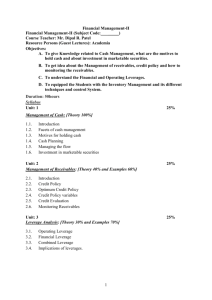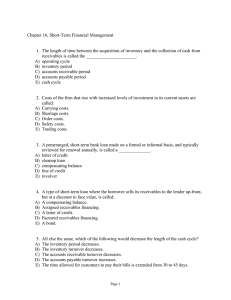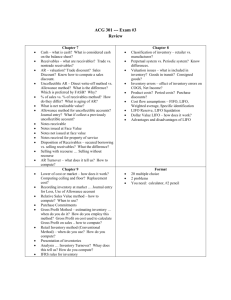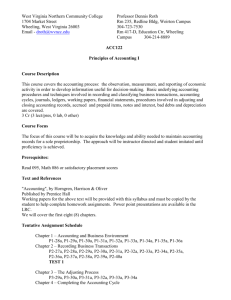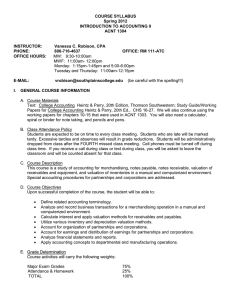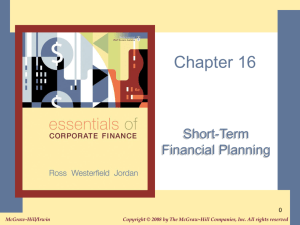Principles of Accounting Competency Exam (PACE)
advertisement
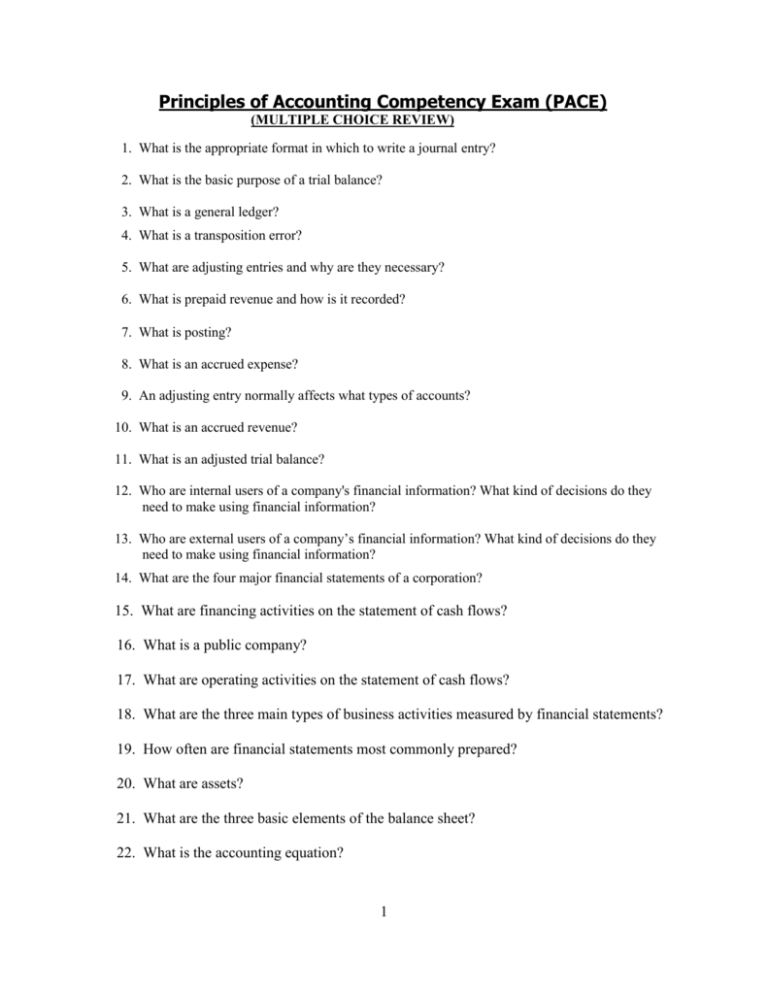
Principles of Accounting Competency Exam (PACE) (MULTIPLE CHOICE REVIEW) 1. What is the appropriate format in which to write a journal entry? 2. What is the basic purpose of a trial balance? 3. What is a general ledger? 4. What is a transposition error? 5. What are adjusting entries and why are they necessary? 6. What is prepaid revenue and how is it recorded? 7. What is posting? 8. What is an accrued expense? 9. An adjusting entry normally affects what types of accounts? 10. What is an accrued revenue? 11. What is an adjusted trial balance? 12. Who are internal users of a company's financial information? What kind of decisions do they need to make using financial information? 13. Who are external users of a company’s financial information? What kind of decisions do they need to make using financial information? 14. What are the four major financial statements of a corporation? 15. What are financing activities on the statement of cash flows? 16. What is a public company? 17. What are operating activities on the statement of cash flows? 18. What are the three main types of business activities measured by financial statements? 19. How often are financial statements most commonly prepared? 20. What are assets? 21. What are the three basic elements of the balance sheet? 22. What is the accounting equation? 1 23. Know the cash inflows and outflows from the statement of cash flows. 24. What is the purpose of a statement of retained earnings? 25. What are expenses? 26. Every financial statement should have "who, what, and when" in its heading. These are? 27. How do notes payable differ from accounts payable? 28. What is earnings per share? 29. Why might a creditor want to look at a company’s financial statements? 30. Why might an investor look at a company's financial statements? 31. What is a sole proprietorship, a partnership, and a corporation? 32. What is a long-term asset? 33. What is a current liability? 34. What is a long-term liability? 35. What is a current asset? 36. What is the minimum number of accounts that must be involved in any transaction? 37. Why are assets depreciated? 38. What is the operating cycle? 39. Why is depreciation added back to net income on the statement of cash flows (indirect method)? 40. What is an asset? 41. How is depreciation calculated using double-declining balance? 42. How is depreciation calculated using straight-line? 43. Which accounts have debit balances and which accounts have credit balances? 44. What is the difference between a permanent and temporary account? 2 45. What are the three key pieces of information that are stated on the bond certificate? 46. What is a contingent liability? 47. Where does unearned revenue appear on the financial statements? 48. What is the relationship of expenses, revenues and dividends to retained earnings? 49. What is the difference between operating income and net income? 50. When should revenue be reported? 51. What is the matching principle? 52. How is a company's income tax expense for the current period computed? 53. What is the first financial statement prepared after the adjusted trial balance? 54. What is the cost principle for assigning a value to purchased assets? 55. What is meant by the time value of money? 56. How do you report a note payable and note receivable? 57. How do you compute interest expense on a loan? 58. What is the relationship between stockholders and the board of directors in a corporation? 59. What is an IPO? 60. Why might a company want to repurchase its stock? 61. How do dividends affect a company’s financial statements? 62. How do stock splits affect the financial statements? 63. What is a current dividend preference? 64. What is a cumulative dividend preference? 65. What are intangible assets? 66. What are tangible assets? 3 67. What is a copyright? 68. What is a patent? 69. What is a trademark? 70. What is a service company, a retail company, a manufacturer and a merchandiser? 71. How do the activities in the operations of a manufacturer differ from the activities of merchandising or service company? 72. Which bank reconciliation items result in an adjusting journal entry on the company's books? 73. In a retail business that uses a perpetual inventory system, scanning a bar code causes adjustments to which accounts? 74. If a company returns an item to a supplier, how will the supplier record the return? 75. What does 2/15, n/30 mean in relation to credit terms? 76. What is the gross profit percentage? 77. Why are companies concerned about the cost of extending credit? 78. How do you record an actual write-off of an uncollectible account? 79. How do you write an adjusting entry to update the balance in the Allowance for Doubtful Accounts account? 80. What is the percent of sales method for estimating bad debts? 81. What is the receivables method for estimating bad debts? 82. What is the difference between trade and non-trade receivables? 83. How is the allowance for doubtful accounts reported on the balance sheet? 84. What is the aging of receivables? 85. What is receivables turnover? 87. What are the main purposes of internal controls? 88. What is separation of duties? 4 89. What is inventory? 90. What is the difference between perpetual and periodic inventory systems? 91. Carrying insufficient quantities of inventory causes what problems? 92. Carrying excessive quantities of inventory causes what problems? 93. Why do some companies have multiple inventory accounts (e.g. Raw Materials, Work-in-Process, and Finished Goods vs Merchandising Inventory)? 94. How do you compute the ending inventory balance and cost of goods sold using FIFO? 95. How do you compute the ending inventory balance and cost of goods sold using LIFO? 96. How do you compute the ending inventory balance and cost of goods sold using Weighted-Average? 5


